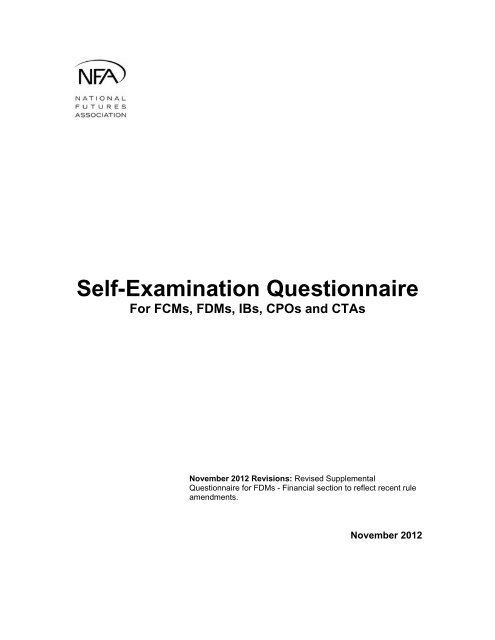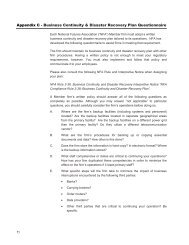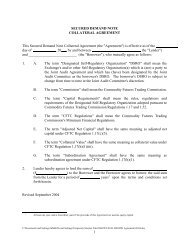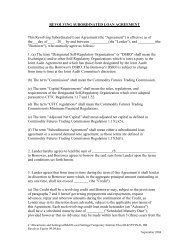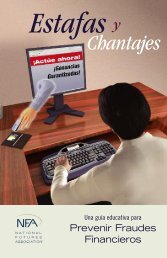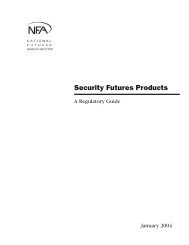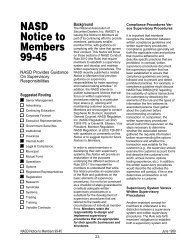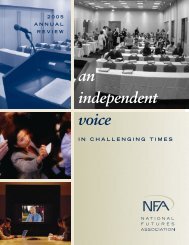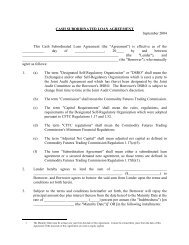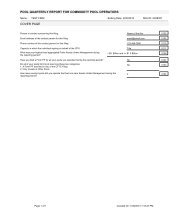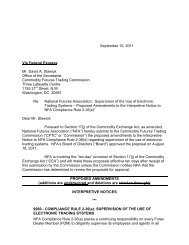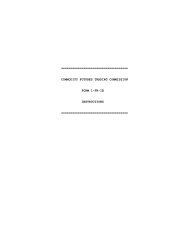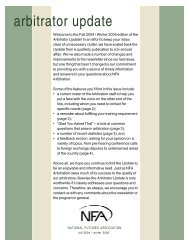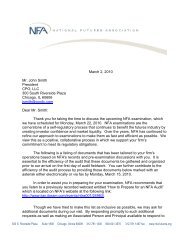Self-Examination Questionnaire - National Futures Association
Self-Examination Questionnaire - National Futures Association
Self-Examination Questionnaire - National Futures Association
Create successful ePaper yourself
Turn your PDF publications into a flip-book with our unique Google optimized e-Paper software.
<strong>Self</strong>-<strong>Examination</strong> <strong>Questionnaire</strong><br />
For FCMs, FDMs, IBs, CPOs and CTAs<br />
November 2012 Revisions: Revised Supplemental<br />
<strong>Questionnaire</strong> for FDMs - Financial section to reflect recent rule<br />
amendments.<br />
November 2012
Table of Contents<br />
Introduction ............................................................................................. 3<br />
Sample Attestation ............................................................................... 4<br />
General <strong>Self</strong>-<strong>Examination</strong> <strong>Questionnaire</strong> for All Members ................ 5<br />
Registration .......................................................................................... 5<br />
Supervision ........................................................................................... 6<br />
Ethics Training................................................................................... .. 8<br />
Business Continuity and Disaster Recovery ........................................ 8<br />
Account Opening .................................................................................. 8<br />
Privacy Rules ....................................................................................... 9<br />
Promotional Material ............................................................................ 9<br />
E-Mails ................................................................................................. 11<br />
Websites and Social Networking Groups ............................................. 11<br />
Supplemental <strong>Questionnaire</strong> for FCMs ................................................ 13<br />
Financial ............................................................................................... 13<br />
Supervision ........................................................................................... 14<br />
Due Diligence Prior to Trading ............................................................. 15<br />
Anti-Money Laundering ........................................................................ 15<br />
Customer Trading ................................................................................. 16<br />
Margins ................................................................................................. 18<br />
Account Statements ............................................................................. 18<br />
Give-up Transactions ........................................................................... 18<br />
Automatic Order Routing System ......................................................... 18<br />
Security <strong>Futures</strong> Products .................................................................... 19<br />
Supplemental <strong>Questionnaire</strong> for FDMs ................................................ 22<br />
Financial ............................................................................................... 22<br />
Disclosure ............................................................................................. 23<br />
Supervision ........................................................................................... 23<br />
Customer Trading and Reporting ......................................................... 24<br />
Security Deposits ................................................................................. 24<br />
Electronic Trading Systems ................................................................. 25<br />
Supplemental <strong>Questionnaire</strong> for IBs .................................................... 27<br />
Supervision of Accounts ....................................................................... 27<br />
Due Diligence Prior to Trading ............................................................. 27<br />
Anti-Money Laundering Program ......................................................... 28<br />
Cash Flow ............................................................................................ 28<br />
Customer Trading ................................................................................. 28<br />
Financial (Independent IBs only) .......................................................... 29<br />
Automatic Order Routing System ......................................................... 30<br />
Security <strong>Futures</strong> Products .................................................................... 31<br />
Supplemental <strong>Questionnaire</strong> for CPOs ................................................ 34<br />
Account Statements ............................................................................. 34<br />
Financial ............................................................................................... 34<br />
Disclosure Document ........................................................................... 35<br />
Security <strong>Futures</strong> Products .................................................................... 36<br />
Supplemental <strong>Questionnaire</strong> for CTAs ................................................ 37<br />
Disclosure Document ........................................................................... 37<br />
Bunched Orders ................................................................................... 37<br />
Post-Execution Allocation of Bunched Orders ..................................... 37<br />
Security <strong>Futures</strong> Products .................................................................... 38<br />
Sources of Additional Information ........................................................ 39<br />
Copyright 2012 by <strong>National</strong> <strong>Futures</strong> <strong>Association</strong><br />
2
Introduction<br />
NFA Compliance Rule 2-9 places a continuing responsibility on every Member to diligently<br />
supervise its employees and agents in all aspects of their futures-related activities, while NFA<br />
Compliance Rule 2-36 (and Compliance Rule 2-39 by reference to Compliance Rule 2-36),<br />
imposes the same requirements on Members with respect to their forex-related activities. NFA<br />
recognizes that, given the differences in the size and complexity of the operations of NFA<br />
Members, there must be some degree of flexibility in determining what constitutes “diligent<br />
supervision” for each firm. It is NFA’s policy to leave the exact form of supervision to the Member,<br />
thereby providing the Member with flexibility to design procedures that are tailored to the<br />
Member’s own situation. However, NFA believes that all Members should regularly review the<br />
adequacy of their supervisory procedures.<br />
In order to satisfy their continuing supervisory responsibilities under Compliance Rules 2-9, 2-36<br />
and 2-39 NFA Members must review their operations on a yearly basis using NFA’s <strong>Self</strong>-<br />
<strong>Examination</strong> <strong>Questionnaire</strong>, which includes a general questionnaire that must be completed by all<br />
Members and five supplemental questionnaires (e.g. FCM, FDM, IB, CPO and CTA) that must be<br />
completed as applicable. The questionnaires are designed to aid Members in recognizing<br />
potential problem areas and to alert them to procedures that need to be revised or strengthened.<br />
The questionnaires focus on the Member’s regulatory responsibilities and solicit information<br />
regarding whether the Member’s internal procedures are adequate for meeting these<br />
responsibilities.<br />
After reviewing the annual questionnaires, an appropriate supervisory person must sign and date<br />
a written attestation stating that they have reviewed the Member’s operations in light of the<br />
matters covered by the questionnaire. Although a Member may review more than one<br />
supplemental questionnaire, only one attestation is necessary per office. A separate attestation<br />
must be made for each branch office and if the branch office reviews its own operations then the<br />
main office must receive a copy of the questionnaire's signed attestation. Guarantor FCMs and<br />
FDMs must obtain copies of the questionnaire's signed attestation from guaranteed IBs, including<br />
branch offices of these guaranteed IBs. These attestations should not be forwarded to NFA but<br />
should be retained by the Member. Signed attestations should be readily available for the most<br />
recent two years and retained for the most recent five years. As necessary, NFA updates these<br />
questionnaires to reflect new and amended rules. Members should obtain the most recent version<br />
of the questionnaires from NFA’s Web site (www.nfa.futures.org). If you have questions, please<br />
contact the NFA Compliance Department at (800) 621-3570.<br />
3
Sample Attestation<br />
(On Member’s Letterhead)<br />
Appropriate supervisory personnel for Member’s Name have reviewed and evaluated the<br />
current procedures of Member’s Name (and branch location, if applicable) using the NFA<br />
<strong>Self</strong>-<strong>Examination</strong> <strong>Questionnaire</strong>. Based on that review, it appears that Member’s Name<br />
current procedures are adequate to meet its supervisory responsibilities.<br />
Signed Date<br />
4
General <strong>Self</strong>-<strong>Examination</strong> <strong>Questionnaire</strong> for All Members<br />
Registration<br />
Has the Member listed all of the following individuals as principals on the Member’s Form<br />
7-R? (Registration Rules 208 and 101(s)):<br />
o Individuals who hold the following positions with the Member:<br />
Sole proprietor of a sole proprietorship;<br />
General partner of a partnership;<br />
Director, president, chief executive officer, chief operating officer, chief<br />
financial officer or a person in charge of a business unit, division or<br />
function subject to regulation by the Commission of a corporation, limited<br />
liability company or limited partnership;<br />
Manager, managing member or a member vested with the management<br />
authority for a limited liability company or limited liability partnership; or<br />
A chief compliance officer.<br />
o Individuals who directly or indirectly, through agreement, holding companies,<br />
nominees, trusts or otherwise, have the following financial relationships to the<br />
Member:<br />
Own 10 percent or more of the outstanding shares of any class of the<br />
Member’s stock, other than non-voting stock;<br />
Are entitled to vote 10 percent or more of any class of the Member‘s<br />
voting securities;<br />
Have the power to sell or direct the sale of 10 percent or more of any<br />
class of the Member’s voting securities;<br />
Have contributed 10 percent or more of a Member’s capital;<br />
Are entitled to receive 10 percent or more of a Member’s net profits.<br />
o Individuals who have the power to exercise a controlling influence over an<br />
applicant’s or registrant’s activities that are subject to regulation by the<br />
Commission.<br />
Has the Member listed all of the following entities as principals on the Member’s Form<br />
7-R? (Registration Rules 208 and 101(s)):<br />
o A general partner of a partnership;<br />
o The direct owner of 10 percent or more of any class of an entity’s securities,<br />
other than non-voting stock; or<br />
o Entities that have directly contributed 10 percent or more of a Member’s capital<br />
unless such capital contribution consists of subordinated debt contributed by:<br />
An unaffiliated bank insured by the Federal Deposit Insurance<br />
Corporation;<br />
5
A United States branch or agency of an unaffiliated foreign bank that is<br />
licensed under the laws of the United States and regulated, supervised<br />
and examined by United States government authorities having regulatory<br />
responsibility for such financial institutions; or<br />
An insurance company subject to regulation by any State.<br />
Has the Member listed all branch office locations and branch office managers on the<br />
Member’s Form 7-R? (Interpretive Notice 9002)<br />
Have all branch office managers passed the branch office manager proficiency exam?<br />
(NFA Compliance Rule 2-7)<br />
Do all branch offices hold themselves out in the name of the Member? (CFTC Regulation<br />
166.4)<br />
Has the Member listed on the Form 7-R or updated on the Form 3-R all “doing business<br />
as” names? (Registration Rules 204 and 210)<br />
Does the Member prohibit individuals who are not registered as APs from soliciting or<br />
accepting customer orders (except in a clerical capacity) or from supervising those<br />
individuals? (CEA Sec 4k)<br />
If the Member terminated any principal’s, branch office manager’s or AP’s affiliation with<br />
the Member, did the Member file with NFA an Individual Withdrawal Notice (CFTC Form<br />
8-T) within 30 days after the termination? (Registration Rule 214)<br />
Is the information provided on the Member’s Form 7-R still accurate and complete. If<br />
there were any changes that rendered the information inaccurate or incomplete, did the<br />
Member update and correct the information on NFA’s Online Registration System?<br />
(Registration Rule 210)<br />
Has the Member reviewed commission payouts and other disbursements to ensure that<br />
only NFA Members are being paid for customer business? (NFA Bylaws 301 and 1101)<br />
Does the Member review all parties it does business with to ensure those that are<br />
required to be registered are registered, and, if required to be an NFA Member, are NFA<br />
Members? (NFA Bylaw 1101 and Compliance Rule 2-36(d))<br />
If the Member or Associate intends to engage in retail forex transactions, has the<br />
Member and Associate designated themselves as a forex firm or forex AP on NFA's<br />
Online Registration System? (NFA Bylaw 301)<br />
Supervision (Compliance Rule 2-9, 2-36 and Interpretive Notices 9019 and 9028)<br />
Has the Member designated a “compliance officer” who is responsible for handling<br />
customer complaints or inquiries of a compliance nature including matters received in<br />
branch offices?<br />
6
Does the Member have a compliance procedures manual or other written documentation<br />
that outlines the Member’s policy with respect to handling compliance matters, such as<br />
customer complaints or inquiries?<br />
Does the Member have a systematic method of recording, investigating and responding<br />
to customer complaints or inquiries?<br />
If the Member has any branch offices or GIBs, does it have an Internal Audit Department<br />
or other designated individual (“Auditor”) who monitors the branch offices and/or GIBs,<br />
including annual on-site inspections, using a written audit program?<br />
o Has the Auditor prepared a written summary of findings noted during an on-site<br />
inspection of a branch office or GIB and submitted the report to a partner or<br />
officer?<br />
o If the Auditor noted any problems during an on-site visit or other during other<br />
monitoring, has the Member taken appropriate corrective action?<br />
Does the Member have policies and procedures regarding the hiring and supervision of<br />
APs who have been or whose past employers have been disciplined by NFA or the CFTC<br />
for fraud?<br />
If the Member or Associate intends to offer retail forex, does the Member have<br />
procedures to screen prospective Associates to ensure that they are qualified and to<br />
determine the extent of supervision they will need if hired?<br />
If the Member or Associate intends to offer retail forex, does the Member have<br />
procedures to screen persons with whom the Member intends to do forex business to<br />
determine if they are required to be registered with the Commission and, if so, to ensure<br />
that they are Members of NFA?<br />
Does the Member supervise sales solicitations by one or more of the following methods:<br />
direct listening, reviewing taped solicitations, silent phone monitoring and customer<br />
contact?<br />
Does the Member provide its APs with training on proper sales solicitations for<br />
transactions in the forex, futures and options markets?<br />
Does the Member distribute changes in rules or regulations to appropriate personnel?<br />
Does the Member monitor incoming and outgoing mail in order to intercept/identify any<br />
customer complaints?<br />
Does an officer or other supervisory personnel regularly review trading in non-customer<br />
and proprietary trading accounts?<br />
If the firm has had any traders with reportable positions, has it filed a Form 40 with the<br />
CFTC? (CFTC Regulation 15.03). If not, the firm must file this form immediately.<br />
7
Ethics Training (Interpretive Notice 9051 and Compliance Rule 2-9)<br />
Does the Member have policies and procedures regarding the ethics training<br />
requirements for APs, detailing areas such as content, frequency and format of training?<br />
For further assistance in drafting these ethics training procedures, see Appendix C on<br />
NFA's website.<br />
Have all of the Member's APs received ethics training in accordance with the firm’s<br />
procedures? Has the Member maintained records documenting compliance with these<br />
procedures, including dates and providers of training and materials used or distributed?<br />
Does the firm use an ethics training provider (either internal or external) who is qualified<br />
to conduct training (e.g. has completed relevant proficiency testing and has three years of<br />
relevant industry experience, or similar experience)?<br />
Business Continuity and Disaster Recovery Plan (Compliance Rule 2-38 and Interpretive<br />
Notice 9052)<br />
Does the firm test its business continuity and disaster recovery plan on a periodic basis<br />
or at least once a year?<br />
Has a supervisory individual reviewed the plan and signed off that review? For further<br />
assistance in drafting a business continuity and disaster recovery plan, see Appendix B<br />
on NFA's website.<br />
Account Opening (Compliance Rules 2-9, 2-10, 2-30 and 2-36)<br />
Does the firm obtain the following information from customers who are individuals: name,<br />
address, occupation or business description, estimated annual income, estimated net<br />
worth, age and prior investment and futures trading experience? For all other non-ECP<br />
customers: name, address, principal business, net worth or net assets and current<br />
estimated annual income (if not available the previous year’s annual income)?<br />
Does the Member require that the necessary information be obtained and recorded prior<br />
to permitting a new account to commence trading?<br />
If an account is opened in the name of an entity, does the Member obtain some type of<br />
authorization signed by appropriate personnel (such as a corporate resolution) indicating<br />
who has the authority to open and trade the account and identifying any account<br />
limitations?<br />
Does the Member require a partner, officer, director, branch office manager or other<br />
supervisory employee to approve a new customer account and document this review?<br />
Does the firm provide adequate risk disclosure to customers prior to opening an account?<br />
If the Member intends to offer retail forex, has the Member provided the customer with<br />
the risk disclosure statement required by CFTC Regulation 5.5(b)?<br />
8
Privacy Rules (CFTC Regulation 160 and NFA Compliance Rule 2-4)<br />
Does the firm have a written privacy policy pertaining to consumer financial information<br />
as required by CFTC Regulation 160? Does the firm provide the privacy notice to<br />
customers at the time the account is opened and annually thereafter?<br />
Does the firm provide and obtain customer “opt out” notices as required?<br />
For further assistance in drafting these privacy procedures, see Appendix D on NFA's<br />
website.<br />
Promotional Material (Compliance Rule 2-29 and 2-36)<br />
Does the Member have written procedures to supervise the preparation and use of<br />
promotional material?<br />
Does the Member require an officer, general partner, sole proprietor, branch office<br />
manager or other supervisory employee other than the individual who prepared the<br />
material to approve promotional material in writing before its use?<br />
Does the Member maintain all promotional materials and written approvals for a period of<br />
five years from the date last used?<br />
Does the Member maintain supporting documentation for all statements, claims and<br />
performance results?<br />
Does the firm ensure that the promotional material includes all material information<br />
necessary to ensure that it is not misleading?<br />
If the material mentions the possibility of profit including the presentation of profitable<br />
past performance results, does the Member include an equally prominent statement of<br />
the risk of loss?<br />
Does the Member calculate rates of return in a manner consistent with CFTC Part 4<br />
Regulations?<br />
Does the Member ensure that any presentation of past performance of any actual<br />
accounts is representative of the actual performance of all reasonably comparable<br />
accounts for the same time period?<br />
Does the Member include a statement that past results are not necessarily indicative of<br />
future results when past performance is mentioned?<br />
Does the Member ensure that statements of opinion are identifiable as such and have a<br />
reasonable basis in fact? Does the Member maintain support for such statements?<br />
Does the Member ensure that the promotional material does not include any guarantee<br />
against loss?<br />
Does the Member ensure that reprints of articles have been supplemented with the<br />
proper disclosures and disclaimers?<br />
9
Does the Member include the hypothetical performance disclaimer prescribed by NFA<br />
Compliance Rule 2-29(c) with any hypothetical performance results? The Member must<br />
cease using hypothetical results when there are three months or more of actual trading<br />
results for the offered program.<br />
When the Member uses hypothetical results for a trading system, does the Member also<br />
include either the actual results of all customer accounts directed by the Member for the<br />
past five years (or entire performance history if less than five years), or if the Member has<br />
less than one year of experience directing accounts, the results of any proprietary trading<br />
over the past five years (or the entire performance history if less than five years)?<br />
Does the Member calculate hypothetical results in the same way as actual results?<br />
When the Member uses both hypothetical results and actual results, does the Member<br />
ensure that the actual results and hypothetical results are appropriately identified,<br />
separately formatted, discussed in an equally balanced manner and calculated pursuant<br />
to the same rate of return method?<br />
Does the Member explain all material assumptions made in preparing hypothetical<br />
results, including at least the minimum investment amount, distribution or reinvestment of<br />
profits, commission charges, management and incentive fees, and the method used to<br />
determine the purchase and sale price for each trade? (Interpretive Notice 9025)<br />
Does the Member submit all radio, television advertisements, audio podcasts and videos<br />
on the internet that make any specific recommendations or refer to or describe the extent<br />
of any profit obtained in the past or that can be achieved in the future to NFA’s<br />
promotional material review team for its review and approval at least 10 days prior to first<br />
use?<br />
Does the Member prohibit the use of promotional material that contains any of the<br />
following? :<br />
Claims regarding seasonal trades;<br />
Claims regarding historical price moves;<br />
Claims regarding price movements that are characterized as conservative<br />
estimates when in fact such price movements would be dramatic;<br />
Claims using certain pricing data for a product different from the one being<br />
marketed in the promotional material;<br />
Claims containing profit projections;<br />
Claims containing “cherry picked” trades; and<br />
Claims regarding mathematical examples of leverage as a means of suggesting<br />
that prospective customers are likely to earn large profits from trading.<br />
10
Does the Member ensure employees and agents are not purchasing leads from non-<br />
Members required to be registered and/or using fraudulent advertising practices? Does<br />
the Member maintain a record of any non-member or member advertisement used?<br />
If the Member intends to offer retail forex, has the Member ensured that its promotional<br />
material does not represent that? :<br />
o forex funds deposited with an FDM are given special protection under the<br />
bankruptcy laws or that assets necessary to satisfy its obligations to customers<br />
are more secure because the Member keeps some or all of those assets at a<br />
regulated entity in the U.S. or a money center country. (Interpretive Notice 9028)<br />
o Its services are commission free without prominently disclosing how it is<br />
compensated in near proximity to that representation. (Interpretive Notice 9028)<br />
o It offers trading with "no-slippage" or that it guarantees the price at which a<br />
transaction is filled (unless it can also demonstrate that all orders for all<br />
customers have been executed and fulfilled at the price initially quoted on the<br />
trading platform when the order was placed and no authority exists, pursuant to a<br />
contract, agreement, or otherwise, to adjust customer accounts in a manner that<br />
would have the direct or indirect effect of changing the price at which an order<br />
was executed). (Interpretive Notice 9028)<br />
o Solicits customers based on the leverage available unless the material balances<br />
any discussion regarding the advantages or leverage with an equally prominent<br />
contemporaneous disclosure that increasing leverage increases risk. (Interpretive<br />
Notice 9028)<br />
E-Mails (Interpretive Notice 9037 and NFA Compliance Rules 2-9 and 2-29)<br />
Does the Member have written procedures to review the use of futures-related e-mail by<br />
employees and agents, which identify by title or position the person responsible for<br />
conducting the review and address how and with what frequency e-mails will be<br />
reviewed, how that review will be documented and what type of e-mails will be prereviewed<br />
and post reviewed?<br />
Does the Member ensure e-mails are in compliance with NFA’s promotional material<br />
content and review procedures?<br />
Websites and Social Networking Groups (Interpretive Notices 9037 and 9063 and NFA<br />
Compliance Rules 2-9 and 2-29)<br />
Does the Member have written procedures to supervise the preparation and use of<br />
websites?<br />
Does the Member require prior review and written approval of the website by an<br />
appropriate supervisor?<br />
11
Does the Member ensure the website meets the standards of content established in<br />
Compliance Rule 2-29.?<br />
Does the Member ensure paid hyperlinks to the firm’s website do not contain deceptive<br />
information regarding futures or options trading?<br />
Does the Member monitor the general content of any websites to which the Member<br />
links?<br />
Does the Member properly review personal websites or on-line social networking groups<br />
used by employees or agents to attract business for the firm?<br />
Does the Member monitor blogs, chat rooms or futures or forex-related forums hosted by<br />
the firm or its Associates and take down any misleading or fraudulent posts and ban<br />
users for egregious or repeat violations?<br />
12
Supplemental <strong>Questionnaire</strong> for FCMs<br />
Financial<br />
Is the preparer of the firm's financial books and records an AP/Principal or under the<br />
direct supervision of an AP/Principal? (CFTC Regulation 1.10 and NFA Financial<br />
Requirements Section 4)<br />
Does the firm balance accounting records on a regular basis? (CFTC Regulation 1.18(a)<br />
and NFA Compliance Rule 2-10)<br />
Does the firm retain financial and compliance records for five years? (Compliance Rule<br />
2-10)<br />
Does the firm maintain a general ledger on an accrual basis? (CFTC Regulation 1.18(a)<br />
and NFA Compliance Rule 2-10)<br />
Does the firm prepare a trial balance on a regular basis? (CFTC Regulation 1.18(a) and<br />
NFA Compliance Rule 2-10)<br />
Does the firm prepare detailed support to convert the trial balance or general ledger to<br />
the financial statement format? (CFTC Regulation 1.18(a) and NFA Compliance Rule 2-<br />
10)<br />
Does the firm prepare monthly capital computations and required 1-FR or FOCUS<br />
statements including supplementary schedules within 17 business days after the month<br />
end? (CFTC Regulation 1.10(a)(2), CFTC Regulation 1.10(b), and NFA Financial<br />
Requirements Section 1(b))<br />
Does the firm file the required 1-FR and FOCUS statement with NFA or the firm’s DSRO,<br />
and the CFTC, by the due dates? (CFTC Regulation 1.10(a)(2), CFTC Regulation<br />
1.10(b), NFA Financial Requirements Section 1, NFA Financial Requirements Section<br />
1(b))<br />
Does the firm prepare daily segregation and secured amount computations by noon of<br />
the following day? (CFTC Regulation 1.32 and NFA Compliance Rule 2-10)<br />
Does the firm monitor intra-day capital compliance? (CFTC Regulation 1.12 and NFA<br />
Financial Requirements Section 4)<br />
Does the firm maintain complete and detailed records of all securities held or owned by<br />
the firm? (CFTC Regulation 1.27)<br />
Does the firm clearly designate all customer securities and property as customer<br />
segregated? (CFTC Regulation 1.20 and NFA Financial Requirements Section 4)<br />
Does the firm review the equity run to ensure accounts of officers, directors, partners and<br />
employees are reflected separately from customers? (NFA Compliance Rules 2-9 and 2-<br />
10)<br />
13
Has the firm submitted subordinated loan agreements to the DSRO for approval at least<br />
10 days before the effective date? In addition, for FCMs that are also registered as<br />
broker-dealers, is a copy of the firm’s securities industry designated examining authority’s<br />
approval filed with NFA immediately upon receipt? (CFTC Regulation 1.17(h)(3(vi) and<br />
NFA Financial Requirements Section 4)<br />
Does the firm maintain written policies and procedures regarding the maintenance of the<br />
FCM's residual interest in its customer segregated and foreign secured accounts that<br />
target amounts (either by percentage or dollars) that the FCM seeks to maintain as its<br />
residual interest and are designed to reasonably ensure the FCM maintains these target<br />
amounts? (NFA Financial Requirements Section 16(a))<br />
Have the procedures been approved in writing by the FCM's Board of Directors, CEO or<br />
CFO? (NFA Financial Requirements Section 16(a))<br />
Have any changes to the FCM's targeted residual amount or any material changes in the<br />
firm's procedures regarding residual interest in customer segregated or foreign secured<br />
accounts been approved in writing by the FCM's Board of Directors, CEO or CFO? (NFA<br />
Financial Requirements Section 16(b) and (c))<br />
Does the firm require that any withdrawal, transfer or disbursement, not made for the<br />
benefit of customers, from any customer segregated or foreign secured account that<br />
exceeded 25% of the firm's residual interest, whether occurring as a single transaction or<br />
multiple transactions in a single day is pre-approved in writing by the FCM's CEO, CFO<br />
or other designated Financial Principal as allowed by NFA Financial Requirements<br />
Section 16? (NFA Financial Requirements Section 16(b) and (c))<br />
Does the firm ensure that written notice signed by the FCM's CEO, CFO or Financial<br />
Principal is immediately filed with NFA upon any withdrawal, transfer or disbursement,<br />
not made for the benefit of customers, from any customer segregated or foreign secured<br />
account that exceeded 25% of the firm's residual interest, whether occurring as a single<br />
transaction or multiple transactions in a single day? (NFA Financial Requirements<br />
Section 16(b) and (c))<br />
Does the firm prepare semi-monthly Segregated Investment Detail Reports (SIDRs) and<br />
file with NFA within one business day? (NFA Financial Requirements Section 16(d))<br />
Supervision<br />
Has the firm provided adequate risk disclosure to customers purchasing deep out-of-themoney<br />
options? (NFA Compliance Rules 2-30 and 2-4)<br />
If the FCM permits its APs to maintain an account at other IBs or FCMs, does the firm<br />
require an AP to obtain written authorization from an appropriate supervisory person of<br />
the firm who will be responsible for reviewing the AP's account and require the AP to<br />
instruct the other IB or FCM to transmit copies of statements and order tickets relating to<br />
14
his/her account to the FCM on a regular basis? (CFTC Regulation 1.55.3(c) and NFA<br />
Compliance Rules 2-9 and 2-10)<br />
Does the FCM maintain records that clearly identify which customer accounts are<br />
discretionary? (NFA Compliance Rule 2-8(a))<br />
Has the firm established written procedures to supervise the trading of discretionary<br />
accounts? (NFA Compliance Rule 2-8(b))<br />
Does the FCM require that an appropriate supervisory person regularly review<br />
discretionary trading activity and prepare a written record of the review of discretionary<br />
accounts? (NFA Compliance Rule 2-8(b))<br />
Does the firm ensure that APs have been continuously registered for a minimum of two<br />
years prior to handling discretionary accounts? (NFA Compliance Rule 2-8(c))<br />
If fees and charges are not determined on a per-trade or round-turn basis, has the firm<br />
provided customers with a written explanation of the charges and reasonable examples<br />
on a per-trade or round-turn basis? (NFA Interpretive Notice 9005 and NFA Compliance<br />
Rule 2-4)<br />
For accounts of employees of other commodity firms, does the firm obtain written<br />
authorization from a person designated by such other FCM or IB with responsibility for<br />
surveillance over the employee's account and transmit regularly to the FCM or IB<br />
customer statements and order tickets for the account. (CFTC Regulation 1.55.3(c) and<br />
NFA Compliance Rule 2-10)<br />
Due Diligence Prior to Trading<br />
Does the firm carefully examine a potential customer’s creditworthiness, business<br />
reputation, market knowledge and anticipated trading patterns before authorizing a<br />
customer to commence trading? (NFA Compliance Rules 2-9 and 2-30)<br />
Does the firm establish margin requirements and risk guidelines or limits for each<br />
customer? Does the firm periodically review these parameters and revise them as<br />
necessary? (NFA Financial Requirements Section 7)<br />
Does the firm provide adequate risk disclosure about the markets appropriate to the<br />
particular customer and type of trading anticipated? (NFA Compliance Rule 2-30)<br />
Has the firm established customer confidentiality procedures to prevent unauthorized use<br />
of customer information and trade data for the benefit of other customers? (CFTC<br />
Regulation 160.30)<br />
Anti-Money Laundering (NFA Compliance Rule 2-9(c) and NFA Interpretive Notice 9045)<br />
Has the firm adopted a policy statement that clearly outlines the firm’s policy against<br />
money laundering and terrorist financing, its commitment to follow all applicable laws to<br />
ensure that its business is not used to facilitate money laundering and the consequences<br />
to employees for not following the firm’s procedures?<br />
15
Does the firm have a written anti-money laundering program that includes: a customer<br />
identification program that enables the firm to form a reasonable belief that it knows the<br />
true identity of each customer; procedures that enable firm personnel to recognize<br />
suspicious customers and transactions, require personnel to report suspicious or unusual<br />
activity or transactions to appropriate supervisory personnel and FinCEN when required,<br />
and ensure that the firm maintains an adequate audit trail to assist law enforcement<br />
agencies in any investigation? For further assistance in drafting an anti-money<br />
laundering program, see Appendix A on NFA's website.<br />
Has the firm ensured that senior management has approved the anti-money laundering<br />
program in writing?<br />
Has the firm provided training at least every 12 months to all of its employees that work in<br />
areas susceptible to money laundering?<br />
Has the program been subject to an independent review at least every 12 months that<br />
tests the adequacy of the program?<br />
Does the firm have a designated person or persons to oversee the AML program who is<br />
either a designated principal or Associate Member or who reports to the firm’s senior<br />
management?<br />
Customer Trading<br />
Does the firm maintain any documents produced or obtained as a result of the order<br />
flow/trading process for a period of five years (i.e., customer order tickets, trade listing,<br />
equity run, customer statements, open position listing, day trade listing, P & S recap)?<br />
(CFTC Regulation 1.31 and 1.35, NFA Compliance Rule 2-10)<br />
For accounts of IBs, does the firm identify the FCM and IB on the account statements?<br />
(CFTC Regulation 1.33(f) and NFA Compliance Rule 2-10)<br />
Does the firm use pre-numbered customer order tickets or assign an internally generated<br />
order number to each order ticket immediately upon receipt of the order from the<br />
customer? (CFTC Regulation 1.35(a-1) and NFA Compliance Rule 2-10)<br />
Does the firm keep all customer order tickets (filled, unfilled, open, canceled)? (CFTC<br />
Regulation 1.35(a) and NFA Compliance Rule 2-10 )<br />
Does the firm record the following information on customer order tickets: date, commodity<br />
options/futures, account identification, quantity long/short, requested price and fill price?<br />
For customer option orders only, does the firm record put or call, strike price and<br />
premium? (CFTC Regulation 1.35(a-1) and NFA Compliance Rule 2-10)<br />
Does the firm ensure that sufficient information to identify the customer from entry<br />
through post-execution reporting is obtained? (CFTC Regulation 1.35(a-1) and NFA<br />
Compliance Rule 2-10)<br />
16
Does the firm identify discretionary customer orders as discretionary? (NFA Compliance<br />
Rule 2-8(a))<br />
For discretionary accounts included in a bunched order, does the firm establish written<br />
procedures to allocate split fills and partial fills in a systematic and non-preferential<br />
manner? (NFA Compliance Rule 2-4, NFA Interpretive Notice 9029)<br />
For bunched orders placed by CTAs, does the firm ensure that required information is<br />
obtained prior to the end of the trading day concerning the number of contracts to be<br />
allocated to each account included in a bunched order along with instructions for the<br />
allocation of split and partial fills among accounts? (NFA Compliance Rule 2-4, NFA<br />
Interpretive Notice 9029)<br />
Does the firm time-stamp futures order tickets immediately upon receipt of the order?<br />
(CFTC Regulation 155.3(c)(2))<br />
Does the firm time-stamp options order tickets immediately upon receipt of the order from<br />
the customer and upon transmission of the order for execution? (CFTC Regulation<br />
1.35(a-1))<br />
Does the firm transmit customer orders executable at or near the market to the floor<br />
before any orders in the same commodity for proprietary accounts or other accounts<br />
affiliated with the firm? (CFTC Regulation 155.3(a))<br />
Does the firm record the fill price when it is received? (CFTC Regulation 1.35(a-1) and<br />
NFA Compliance Rule 2-10)<br />
Does the firm promptly call the customer with the fill information? (Recommended Best<br />
Practice)<br />
Does the firm prohibit the inclusion of discretionary and non-discretionary orders on a<br />
block order? (CFTC Regulation 155.3(a))<br />
Does the firm prohibit trades for proprietary and non-customer accounts to be combined<br />
with customer orders on block orders? (CFTC Regulation 155.3(a))<br />
Margins<br />
Does the firm make margin calls when an account is under margined? (NFA Financial<br />
Rules Section 7)<br />
Does the firm prepare a written daily listing of outstanding calls that indicates the number<br />
of days the call is outstanding? (Recommended Best Practice)<br />
Does the firm collect margin calls in a timely manner? (Financial Requirements Section<br />
7)<br />
Does the firm accept only immediately available funds from omnibus accounts–<br />
Acceptable forms are wire transfers or certified checks? (NFA Compliance Rule 2-33)<br />
Does the firm set a pre-determined length of time allowed for the collection of outstanding<br />
margin calls? (Recommended Best Practice)<br />
17
Does the firm aggregate related accounts as if they were one account when determining<br />
if excess margin is available for withdrawal? (Financial Requirements Section 7)<br />
Does the firm margin domestic omnibus accounts on a gross basis? (Financial<br />
Requirements Section 7 and CFTC Regulation 1.58)<br />
Does the firm obtain current margin rates and SPAN risk parameters on a regular or daily<br />
basis? (Financial Requirements Section 7)<br />
Account Statements<br />
Does the firm mail confirmation statements to customers no later than the business day<br />
after the customer transaction? (CFTC Regulation 1.33(b))<br />
Does the firm mail monthly statements to active customers promptly after every month<br />
end and inactive customers at least every three months? (CFTC Regulation 1.33(a))<br />
Does the firm forward daily and monthly trade confirmations by means of electronic<br />
media to any customer who consents to delivery by that method, subject to certain<br />
conditions? (CFTC Regulation 1.33(g))<br />
Does the firm offset positions on a FIFO basis unless the customer gives other<br />
instructions? (NFA Compliance Rule 2-10 and CFTC Regulation 1.46)<br />
Give-Up Transactions<br />
Does the firm know their rights and responsibilities for a give-up transaction?<br />
(Recommended Best Practice)<br />
Does the executing broker notify the carrying broker promptly after an order has been<br />
executed if a customer has initiated trades that, in the circumstances, appear to deviate<br />
significantly from the customer’s normal trading activities? (Recommended Best<br />
Practice)<br />
Does the executing broker provide all relevant trade information to the carrying broker as<br />
soon as practicable after a trade has been executed? (Recommended Best Practice)<br />
Does the carrying broker keep a list of customers’ executing brokers and adopt<br />
procedures to assure that the list is current? Does the carrying broker establish and<br />
communicate to an executing broker limits (e.g., order size, daily aggregate positions) on<br />
the trades that the executing broker can accept for each customer? (Recommended<br />
Best Practice)<br />
Automatic Order Routing System (NFA Interpretive Notice 9046 and NFA Compliance Rules<br />
2-4, 2-9 and 2-10)<br />
Has the firm established written procedures to ensure that:<br />
o The order-routing process protects the integrity and confidentiality of orders and<br />
account information at all points during the process?<br />
o The delivery and reporting of customers orders is timely and efficient? Customer<br />
complaints about order delivery and reporting are addressed expeditiously?<br />
18
o The system monitors trading and imposes controls on trading activity for each<br />
customer in order to prevent the customer from entering into trades that create<br />
undue financial risks for the firm or its other customers?<br />
Does the firm disclose pertinent information about the Automatic Order Routing System,<br />
including, but not limited to the following? :<br />
o The time frame established for completion of transactions.<br />
o The time frame and process for informing customers of exceptions to normal<br />
processing of orders or requests.<br />
o Days and hours of operation.<br />
o Fees, commissions or costs associated with the transaction. Information to<br />
enable customers to file claims, ask questions, register complaints and obtain<br />
information on customer recourse.<br />
Has the firm established security appropriate to protect internal systems from viruses and<br />
malicious code and to prevent unauthorized access?<br />
Does the firm monitor security procedures and update due to technology changes?<br />
Does the firm identify and authenticate authorized users and the protection of personally<br />
identifiable information? This should include limiting access to systems and data only to<br />
authorized employees based upon their assigned roles and responsibilities, using<br />
encryption or other equivalent security procedure to protect the transmission of<br />
information, and preventing customers from accessing others’ information.<br />
Has the firm established procedures to disclose to users any breaches or possible<br />
breaches to the system?<br />
Has the firm established procedures to monitor availability and capacity compared to the<br />
disclosed commitments and provide for expected future requirements?<br />
Does the firm document, authorize, test and approve proposed system changes before<br />
implementation to protect the availability of the system?<br />
Does the firm provide for backup, offsite storage, restoration and disaster recovery<br />
processes sufficient to achieve the disclosed availability commitments?<br />
Does the firm ensure policies are current with disclosed business practices, laws and<br />
regulations?<br />
Security <strong>Futures</strong> Products (Rules and Resources and NFA Compliance Rule 2-37 and<br />
Interpretive Notices 9043, 9044, 9049 and 9050)<br />
Does the Member have a designated security futures principal at each main or branch<br />
office?<br />
Does the Member check the Central Registration Depository (CRD) for information on<br />
prospective employees who will be involved in security futures activities and obtain and<br />
review a copy of the individual’s most recent Form 8-T or U5?<br />
19
Does the Member require APs to complete appropriate security futures products training<br />
modules?<br />
Does the Member ensure that the firm’s written procedures address the following? :<br />
o Compliance with applicable securities laws, including Sections 9(a), 9(b), and<br />
10(b) of the Securities Exchange Act of 1934.<br />
o The review and approval of customer accounts including:<br />
Specific criteria and standards to be used in evaluating the suitability of a<br />
customer to engage in security futures transactions.<br />
Specific procedures for approving accounts to engage in security futures<br />
transactions, including requiring written approval by a designated<br />
security futures principal.<br />
A requirement that the designated security futures principal explain, in<br />
writing, why he or she has approved an account that does not meet the<br />
specific criteria and standards set forth in the procedures.<br />
Specific financial requirements for initial approval and maintenance of<br />
customer accounts that engage in security futures transactions.<br />
Before entering into a guarantee agreement with an IB, does the Member check the<br />
Central Registration Depository (CRD) for any derogatory information on the IB, its<br />
principals and its employees who will be involved in security futures activities?<br />
Does the Member provide the risk disclosure statement required by Compliance Rule 2-<br />
30(b) prior to approving an account to trade security futures?<br />
Does the Member obtain the following additional information from customers before<br />
commencing trading? :<br />
o Identification that the customer account is speculative or hedge;<br />
o Employment status;<br />
o Estimated liquid net worth;<br />
o Marital status; and<br />
o Number of dependents.<br />
Does the Member require that the customer account record include the name of the<br />
Associate, how the customer account information was obtained and the date the required<br />
risk disclosure statement was provided?<br />
Does the Member ensure that on an annual basis, customers are provided with written<br />
notice regarding NFA’s Background Affiliation Status Information Center (BASIC) at<br />
www.nfa.futures.org/basicnet?<br />
Does the Member notify NFA within 10 business days of any required reportable events?<br />
Does the Member submit a quarterly report to NFA regarding written customer<br />
complaints?<br />
20
Does the Member ensure that promotional material meets the following requirements? :<br />
o Prominently identifies the Member;<br />
o Includes the date that the material was first used;<br />
o Provides contact information for obtaining a copy of the disclosure statement for<br />
security futures products;<br />
o States that security futures products are not suitable for all customers;<br />
o Does not include any statement suggesting that security futures positions can be<br />
liquidated at any time;<br />
o Does not include any cautionary statement, caveat, or disclaimer that is not<br />
legible, that attempts to disclaim responsibility for the content of the promotional<br />
material or the opinions expressed in the material, that is misleading, or that is<br />
otherwise inconsistent with the content of the material;<br />
o Discloses the source of any statistical tables, charts, graphs or other illustrations<br />
from a source other than the Member, unless the source of the information is<br />
otherwise obvious;<br />
o States that supporting documentation will be furnished upon request if it includes<br />
any claims, comparisons, recommendations, statistics or other technical data;<br />
o If soliciting for a trading program that will be managed by an FCM or IB or<br />
Associate of an FCM or IB, it includes the cumulative performance history of the<br />
Member’s customers or states that the trading program is unproven;<br />
o Refers to past recommendations regarding security futures products, the<br />
underlying securities, or a derivative thereof only if it lists all similar<br />
recommendations made by the Member or Associate within the last year;<br />
o Includes current recommendations regarding security futures products only if: (i)<br />
the Member has a reasonable basis for the recommendation; (ii) the material<br />
discloses all material conflicts of interest created by the Member’s or Associate’s<br />
activities in the underlying security; and (iii) the material contains contact<br />
information for obtaining a list of prior recommendations;<br />
o Includes only a general description of the security futures products for which<br />
accounts, orders, trading authorization, or pool participations are being solicited;<br />
the name of the Member; and contact information for obtaining a copy of the<br />
current disclosure statement for security futures products; (unless the<br />
promotional material is accompanied or preceded by the disclosure statement for<br />
security futures products); and<br />
o Has been submitted to NFA for review and approval at least ten days prior to first<br />
use if it reaches or is designed to reach a public audience through mass media.<br />
21
Supplemental <strong>Questionnaire</strong> for FDMs<br />
Financial<br />
Is the preparer of the firm's financial books and records an AP/Principal or under the<br />
direct supervision of an AP/Principal? (NFA Financial Requirements Section 13)<br />
Does the firm balance accounting records on a regular basis? (CFTC Regulation 5.14<br />
and NFA Compliance Rule 2-36(k))<br />
Does the firm retain financial and compliance records for five years? (CFTC Regulation<br />
5.14 and NFA Compliance Rule 2-36(k))<br />
Does the firm maintain a general ledger on an accrual basis? (CFTC Regulation 5.14<br />
and NFA Compliance Rule 2-36(k))<br />
Does the firm prepare a trial balance on a regular basis? (CFTC Regulation 5.14 and<br />
NFA Compliance Rule 2-36(k))<br />
Does the firm prepare and maintain detailed support to convert the trial balance or<br />
general ledger to the financial statement format? (CFTC Regulation 5.14 and NFA<br />
Compliance Rule 2-36(k))<br />
Does the firm prepare monthly capital computations and required 1-FR or Focus<br />
statements including supplementary schedules within 17 business days after the month<br />
end? (CFTC Regulation 5.12 and NFA Financial Requirements Section 11)<br />
Does the firm file the required 1-FR and Focus statement with NFA or the firm’s DSRO,<br />
and the CFTC, by the due dates? (CFTC Regulation 5.12 and NFA Financial<br />
Requirements Section 11)<br />
Does the firm prepare Forex daily reports each business day and file the reports by noon<br />
on the following business day? (NFA Financial Requirements Section 13)<br />
Does the firm prepare monthly operational risk reports and quarterly reports with up-todate<br />
performance disclosures within 17 business days after the end of each month or<br />
quarter for which the report is prepared? (NFA Financial Requirements Section 13)<br />
Does the firm monitor trading activity to ensure intra-day capital compliance and file the<br />
appropriate notices with NFA, other DSROs and the CFTC if the firm falls below required<br />
capital levels? (CFTC Regulation 5.16 and NFA Compliance Rule 2-36(k))<br />
For purposes of determining adjusted net capital under CFTC Regulation 5.7<br />
(incorporating CFTC Regulation 1.17), does the firm ensure it has not included assets<br />
held by an affiliate (unless approved by NFA) or an unregulated person in its current<br />
assets? An affiliate is any person that controls, is controlled by, or is under common<br />
control with the Forex Dealer Member. (NFA Financial Requirements Section 11)<br />
Does the firm maintain complete and detailed records of all securities held or owned by<br />
the firm? (CFTC Regulation 5.14 and NFA Compliance Rule 2-36(k))<br />
22
On a periodic basis, does the firm review the equity run to ensure accounts of officers,<br />
directors, partners and employees are reflected separately from customers? (CFTC<br />
Regulation 5.8 and NFA Compliance Rule 2-36(k))<br />
Has the firm submitted all subordinated loan agreements to the firm’s DSRO for approval<br />
at least 10 days before the effective date? In addition, for Forex Dealer Members that<br />
are also registered as broker-dealers, is a copy of the firm’s securities industry<br />
designated examining authority’s approval filed with NFA? (CFTC Regulation 5.7 and<br />
NFA Compliance Rule 2-36(k))<br />
On a daily basis, does the firm calculate the amount owed to customers for forex<br />
transactions and ensure it holds assets equal to or in excess of that amount, at one or<br />
more qualifying institutions in the United States or money center countries as defined in<br />
CFTC Regulations 1.49 and 5.8 and in accordance with NFA Financial Requirements<br />
Sections 11 and 14?<br />
Disclosure<br />
Prior to opening a customer account, does the firm provide customers with a risk<br />
disclosure statement that meets the criteria of CFTC Regulation 5.5 and obtain a signed<br />
and dated acknowledgement from the customer indicating that he/she received and<br />
understood the statement? Does the firm ensure that the statement includes the<br />
performance disclosures required by CFTC Regulation 5.5(e)? (CFTC Regulation 5.5<br />
and NFA Compliance Rule 2.36(k)).<br />
Does the firm provide customers with information relating to NFA's BASIC system prior to<br />
engaging in Forex transactions and annually thereafter? (NFA Compliance Rule 2-36(f)<br />
and NFA Interpretive Notice 9053)<br />
Supervision<br />
Has the firm designated a Chief Compliance Officer(s) who is also listed as a principal(s)<br />
of the firm per NFA's Online Registration System? (CFTC Regulation 5.18(g) and NFA<br />
Compliance Rule 2-36(j))<br />
Does the firm have a process in place to establish, maintain, review, modify and test<br />
policies and procedures that are reasonably designed to achieve compliance with the<br />
CEA, CFTC Regulations and orders thereunder, and NFA Requirements? Has the CCO<br />
filed the annual certification (to be filed at the time it files its annual certified financial<br />
report) that the FDM has compliance processes in place and that the CCO has apprised<br />
the FDM's CEO (or equivalent management personnel) of the FDM's compliance efforts<br />
to date, as well as identified any significant compliance problems and the CCO's plan to<br />
address those problems? (NFA Compliance Rule 2-36(j) and CFTC Regulation 5.18(g))<br />
Has the firm ensured that no AP, principal, or the firm itself maintains discretion over<br />
customer accounts? (CFTC Regulation 5.2(c) and NFA Compliance Rule 2-36(k))<br />
23
For third party discretionary accounts, does the firm review these accounts on a periodic<br />
basis and maintain written evidence of the review? (NFA Compliance Rule 2-36(e))<br />
Does the firm establish, maintain and enforce written supervisory procedures over the<br />
Member's forex business, including the activities of the Member's Associates and<br />
agents? (NFA Compliance Rule 2-36(e))<br />
Does the firm screen the background of prospective Associates, as well as persons who<br />
introduce customer business or manage customer accounts? (NFA Compliance Rule<br />
2-36 and NFA Interpretive Notice 9053)<br />
Does the firm establish, maintain and enforce written supervisory procedures over the<br />
activities of third parties with which it does business? (NFA Compliance Rule 2-36(e) and<br />
NFA Interpretive Notice 9053)<br />
Does the firm conduct an annual on-site visit to branch offices, guaranteed IBs and<br />
affiliates with which it conducts forex business? (NFA Compliance Rule 2-36(e) and NFA<br />
Interpretive Notice 9053)<br />
Does the firm maintain a record of any communication regarding possible violations of<br />
the CEA or CFTC Regulations? The record must include the name of complainant (if<br />
known), date of the communication, the agreement, contract or transaction at issue, the<br />
substance of the communication and the name of the person who received the<br />
communication. Does the firm provide CFTC Division of Enforcement an electronic copy<br />
of these communications no later than 30 days after it is received or within 3 business<br />
days if the communication concerns facts giving rise to possible fraud under the CEA or<br />
CFTC Regulations? (CFTC Regulation 5.18(g) and NFA Compliance Rule 2-36(k))<br />
Customer Trading and Reporting<br />
Does the firm maintain procedures to monitor the activity in customer accounts and<br />
maintain written evidence of the review? (NFA Compliance Rule 2-36(e))<br />
Does the firm ensure that any price adjustments have been made in accordance with<br />
NFA Compliance Rule 2-43?<br />
Does the firm report price adjustments to NFA on a weekly basis? (NFA Compliance<br />
Rule 2-36(e) and NFA Interpretive Notice 9060)<br />
Does the firm provide daily, monthly (or quarterly where applicable) account statements<br />
required under CFTC Regulation 5.13 that prominently display the account's equity? The<br />
account equity is the sum of all realized profits and losses, all unrealized profits and<br />
losses, and any other cash and collateral in the account.<br />
Security Deposits (CFTC Regulation 5.9 and NFA Financial Requirements Section 12)<br />
Does the firm collect and maintain the required security deposit for any customer that is<br />
not an eligible contract participant?<br />
24
Does the firm review customer accounts to ensure that customers are in compliance with<br />
security deposit requirements?<br />
Does the firm require customers to post additional security deposits when their account<br />
falls below security deposit requirements?<br />
Does the firm collect additional security deposits in a timely manner?<br />
Does the firm liquidate the customer’s positions if the customer does not post any<br />
additional security deposit necessary to maintain the required security deposit amount?<br />
Electronic Trading Systems (CFTC Regulation 5.18, NFA Compliance Rule 2-36(e), and NFA<br />
Interpretive Notice 9060)<br />
Has the firm established ETS procedures in accordance with NFA's Interpretive Notice<br />
and CFTC Regulation 5.18? At a minimum, the firm's procedures must address security,<br />
capacity, integrity, recordkeeping, and credit and risk management controls.<br />
Did the firm provide NFA with a copy of these procedures?<br />
Has the firm assigned the responsibility for complying with the ETS Notice to individuals<br />
who are under the ultimate supervision of an associated person who is also a listed<br />
principal?<br />
Has the firm notified NFA about its current trading platforms in use?<br />
Does the firm notify NFA if they change their trading platforms?<br />
Does the firm ensure that the system produces profit and loss reports, assessment<br />
reports and exception reports?<br />
If the FDM whitelabels a platform of another FDM, the FDM may rely on the procedures<br />
of the sponsor FDM. However, if the FDM whitelabels a non-FDM system, does the firm<br />
ensure that the whitelabel sponsor is complying with NFA's ETS Interpretive Notice?<br />
Does the firm ensure that an AP who is also a principal certifies annually that the system<br />
is in compliance with NFA's Requirements?<br />
Does the firm conduct periodic reviews of the system and document these reviews?<br />
Does the firm maintain a record of how rollovers are calculated?<br />
Does the firm maintain a record of the method used to calculate the bid/ask spread?<br />
Does the firm ensure that the system provides customers symmetrical re-quoting? This<br />
means if you provide a retail forex customer a new bid price for a retail forex transaction<br />
that is lower than its previous bid, you must provide a new asked price that is also lower<br />
than its previously asked price by a similar amount. This also means if you provide a<br />
retail forex customer a new bid price for a retail forex transaction that is higher than its<br />
previous bid, you must provide a new asked price that is also higher than its previously<br />
asked price by a similar amount.<br />
Has the firm established and implemented a prompt and effective method to notify<br />
customers when operational difficulties occur?<br />
25
Has the firm established and implemented a procedure to inform NFA no later than 24<br />
hours after an outage of the firm’s trading system has occurred?<br />
Has the firm provided customers with advance disclosure of factors that may adversely<br />
impact a firm's system?<br />
26
Supplemental <strong>Questionnaire</strong> for IBs<br />
Supervision of Accounts<br />
If the IB permits its APs to maintain an account at other IBs or FCMs, does the firm<br />
require the AP to obtain written authorization from an appropriate supervisory person of<br />
the IB who will be responsible for reviewing the AP's account and require the AP to<br />
instruct the other IB or FCM to transmit copies of statements and order tickets relating to<br />
his/her account to the IB on a regular basis? (CFTC Regulation 1.55 and NFA<br />
Compliance Rules 2-9 and 2-10)<br />
Does the IB maintain records that clearly identify which customer accounts are<br />
discretionary? (NFA Compliance Rule 2-8(b))<br />
Does the IB have written procedures to supervise the trading of discretionary accounts?<br />
(NFA Compliance Rule 2-8(b))<br />
Does the IB require that an appropriate supervisory person regularly reviews<br />
discretionary trading activity and prepare a written record of the review? (NFA<br />
Compliance Rule 2-8(b))<br />
Does the firm ensure that APs have been continuously registered for a minimum of two<br />
years prior to handling discretionary accounts? (NFA Compliance Rule 2-8(c))<br />
If the IB accepts accounts controlled by a third party, does the IB obtain a copy of the<br />
account controller’s written trading authorization or a written acknowledgment from the<br />
customer that such authorization has been given prior to accepting any orders from the<br />
third party? (NFA Compliance Rule 2-8)<br />
If the IB imposes fees and/or charges that are not determined on a per-trade or roundturn<br />
basis, does the IB provide customers with a complete written explanation of the<br />
charges? (NFA Interpretive Notice 9005 and NFA Compliance Rule 2-4).<br />
Due Diligence Prior to Trading<br />
Does the IB review the financial standing of omnibus accounts and commodity pools<br />
before the accounts are accepted? (NFA Compliance Rule 2-9)<br />
Does the IB carefully examine a potential customer’s creditworthiness, business<br />
reputation, market knowledge and anticipated trading patterns before authorizing a<br />
customer to commence trading? (NFA Compliance Rules 2-9 and 2-30)<br />
Does the IB provide adequate and appropriate risk disclosure about the markets<br />
appropriate based on the particular customer and type of trading anticipated? (NFA<br />
Compliance Rules 2-4 and 2-30)<br />
If the IB trades one or more proprietary accounts, either on its own behalf or for an<br />
affiliate, does the IB have clearly defined trading objectives and loss limits or risk<br />
guidelines consistent with these objectives? If the IB has granted trading authority to an<br />
account manager or relies on individuals to implement the entity’s objectives, has the IB<br />
27
instituted appropriate procedures to protect against unauthorized trading by employees or<br />
independent account managers? (NFA Compliance Rules 2-9 and 2-4)<br />
Anti-Money Laundering Program (NFA Compliance Rule 2-9(a) and NFA Interpretive Notice<br />
9045)<br />
Has the firm adopted a policy statement that clearly outlines the firm’s policy against<br />
money laundering and terrorist financing, its commitment to follow all applicable laws to<br />
ensure that its business is not used to facilitate money laundering and the consequences<br />
to employees for not following the firm’s procedures?<br />
Does the firm have a written anti-money laundering program that includes: a customer<br />
identification program that enables the firm to form a reasonable belief that it knows the<br />
true identity of each customer; procedures that enable firm personnel to recognize<br />
suspicious customers and transactions, require personnel to report suspicious or unusual<br />
activity or transactions to appropriate supervisory personnel and FinCEN when required,<br />
and ensure that the firm maintains an adequate audit trail to assist law enforcement<br />
agencies in any investigation? See Appendix A for assistance in drafting an AML<br />
program.<br />
Has a member of the firm’s senior management approved the AML program in writing?<br />
Has the firm provided training at least every 12 months to all of its employees that work in<br />
areas susceptible to money laundering?<br />
Has the program been subject to an independent review at least every 12 months that<br />
tests the adequacy of the program?<br />
Does the firm have a designated person or persons to oversee the AML program who is<br />
either a designated principal or Associate Member or who reports to the firm’s senior<br />
management?<br />
Cash Flow (CFTC Regulation 1.57 and NFA Compliance Rules 2-4)<br />
Does the IB prohibit employees or agents from accepting any money or other property<br />
from customers except checks that are made payable to the FCM? (CFTC Regulation<br />
1.57).<br />
If the IB accepts checks made payable to the FCM, has the IB received written<br />
authorization from the FCM to do so, and does the IB deposit the check in a qualifying<br />
bank account or forward the check to the FCM on the same day the check is received?<br />
(CFTC Regulation 1.57).<br />
Customer Trading<br />
Does the IB provide the carrying broker with the account numbers at the time a trade is<br />
placed? (NFA Interpretive Notice 9029 and NFA Compliance Rule 2-10)<br />
Does the IB maintain any documents produced or obtained as a result of the order<br />
flow/trading process for a period of five years (i.e., customer order tickets, trade listing,<br />
28
equity run, customer statements, open position listing, day trade listing, P & S recap)?<br />
(CFTC Regulation 1.31 and NFA Compliance Rule 2-10)<br />
Does the IB keep all customer order tickets (filled, unfilled, open, canceled)? (CFTC<br />
Regulation 1.31 and NFA Compliance Rule 2-10)<br />
Does the IB use pre-numbered customer order tickets or assign an internally generated<br />
order number to each order ticket immediately upon receipt of the order from the<br />
customer? (CFTC Regulation 1.35(a-1) and NFA Compliance Rule 2-10)<br />
Does the IB record the following information on customer order tickets: date, commodity<br />
options/futures, account identification, quantity long/short, requested price and fill price?<br />
For customer option orders only, does the IB record put or call, strike price and premium?<br />
(CFTC Regulation 1.35(a-1) and NFA Compliance Rule 2-10)<br />
Does the IB time-stamp futures order tickets immediately upon receipt of the order?<br />
(CFTC Regulation 1.35(a-1) and NFA Compliance Rule 2-10)<br />
Does the IB time-stamp options order tickets immediately upon receipt of the order from<br />
the customer and upon transmission of the order for execution? (CFTC Regulation<br />
1.35(a-1) and NFA Compliance Rule 2-10)<br />
Does the IB immediately call the carrying broker or the floor directly upon receipt of a<br />
customer order during market hours? (CFTC Regulation 155.4 and NFA Compliance<br />
Rule 2-4)<br />
Does the IB transmit customer orders executable at or near the market to the floor before<br />
any orders in the same commodity for proprietary accounts or other accounts affiliated<br />
with the firm? (CFTC Regulation 155.4 and NFA Compliance Rule 2-4)<br />
Does the IB promptly call the customer with the fill information? (Recommended Best<br />
Practice)<br />
Does the IB prohibit discretionary orders and non-discretionary orders from being<br />
included in the same bunched order? (CFTC Regulation 155.4 and NFA Compliance<br />
Rule 2-4)<br />
Does the IB prohibit trades for proprietary and non-customer accounts from being<br />
combined with customer orders on block orders? (CFTC Regulation 155.4)<br />
Does the IB have procedures to identify and investigate in a timely manner unusual<br />
activity within or among accounts that may indicate illicit trading practices; including large<br />
or non-routine account transfers, account number changes and error accounts that<br />
appear to be used for trading purposes? (NFA Compliance Rules 2-9 and Rule 2-4)<br />
Financial (Independent IBs only)<br />
Does the IB monitor for daily capital compliance? (NFA Financial Requirements Section<br />
5 and NFA Compliance Rule 2-10)<br />
29
Does the IB maintain a general ledger on an accrual basis? (CFTC Regulation 1.18 and<br />
NFA Compliance Rule 2-10)<br />
Does the IB balance accounting records on a regular basis? (CFTC Regulation 1.18 and<br />
NFA Compliance Rule 2-10)<br />
Does the IB prepare a trial balance on a regular basis? (CFTC Regulation 1.18 and NFA<br />
Compliance Rule 2-10)<br />
Does the IB prepare detailed support to convert the trial balance or general ledger to the<br />
financial statement format? (CFTC Regulation 1.18 and NFA Compliance Rule 2-10)<br />
Does the IB maintain complete and detailed records of all securities held or owned by the<br />
firm? (CFTC Regulation 1.18 and NFA Compliance Rule 2-10)<br />
Does the IB review positions in the firm’s trading account to determine their effect on the<br />
firm’s compliance with minimum capital requirements? (CFTC Regulation 1.18 and NFA<br />
Compliance Rule 2-10)<br />
Does the IB prepare monthly capital computations within 17 business days after the<br />
month end? (CFTC Regulation 1.18 and NFA Compliance Rule 2-10)<br />
Does the IB prepare required 1-FR or Focus statements including Supplementary<br />
Schedules and file them with NFA or the DSRO, and the CFTC, by the due dates?<br />
(CFTC Regulation 1.10 and NFA Compliance Rule 2-10)<br />
Has the IB submitted all subordinated loan agreements to the firm’s DSRO for approval<br />
at least 10 days before the effective date? In addition, for IBs that are also registered as<br />
broker-dealers, is a copy of the firm’s securities industry designated examining authority’s<br />
approval filed with NFA? (CFTC Regulation 1.17 and NFA Compliance Rule 2-10)<br />
Does the IB retain financial and compliance records for five years? (CFTC Regulation<br />
1.31 and NFA Compliance Rule 2-10)<br />
Automatic Order Routing System (NFA Interpretive Notice 9046 and NFA Compliance Rules<br />
2-4, 2-9 and 2-10)<br />
For an IB that permits a customer to use an automated order routing system,<br />
Does the IB have written procedures to ensure that:<br />
o The order-routing process protects the integrity and confidentiality of orders and<br />
account information at all points during the process?<br />
o The delivery and reporting of customer orders is timely and efficient?<br />
o Customer complaints about order delivery and reporting are handled<br />
expeditiously?<br />
o The system monitors trading and imposes controls on trading activity for each<br />
customer in order to prevent the customer from entering into trades that create<br />
undue financial risks for the firm or its other customers?<br />
30
Does the IB disclose pertinent information about the Automatic Order Routing System,<br />
including, but not limited to the following? :<br />
o The time frame established for completion of transactions;<br />
o The time frame and process for informing customers of exceptions to normal<br />
processing of orders or requests;<br />
o Days and hours of operation;<br />
o Fees, commissions or costs associated with the transaction; and<br />
o Information to enable customers to file claims, ask questions, register complaints<br />
and obtain information on customer recourse.<br />
Does the IB establish security appropriate to protect internal systems from viruses and<br />
malicious code and to prevent unauthorized access?<br />
Does the IB monitor security procedures and updates due to technology changes?<br />
Does the IB identify and authenticate authorized users? Does the IB ensure that<br />
personally identifiable information is protected? This should include limiting access to<br />
systems and data only to authorized employees based upon their assigned roles and<br />
responsibilities, using encryption or other equivalent security procedure to protect the<br />
transmission of information, and preventing customers from accessing others’<br />
information.<br />
Does the IB have procedures to disclose to users any breaches or possible breaches to<br />
the system?<br />
Does the IB have procedures to monitor availability and capacity compared to the<br />
disclosed commitments and provide for expected future requirements?<br />
Does the IB document, authorize, test and approve proposed system changes before<br />
implementation to protect the availability of the system?<br />
Does the IB provide for backup, offsite storage, restoration and disaster recovery<br />
processes sufficient to achieve the disclosed availability commitments?<br />
Does the IB ensure policies are current with disclosed business practices, laws and<br />
regulations?<br />
Security <strong>Futures</strong> Products (Rules and Resources and NFA Compliance Rule 2-37 and<br />
Interpretive Notices 9043, 9044, 9049 and 9050)<br />
Does the Member have a designated security futures principal at each main or branch<br />
office?<br />
Does the Member check the Central Registration Depository (CRD) for information on<br />
prospective employees who will be involved in security futures activities and obtain and<br />
review a copy of the individual’s most recent Form 8-T or U5?<br />
Does the Member require APs to complete appropriate security futures products training<br />
modules?<br />
31
Does the Member ensure that the firm’s written procedures address the following? :<br />
o Compliance with applicable securities laws, including Sections 9(a), 9(b), and<br />
10(b) of the Securities Exchange Act of 1934.<br />
o The review and approval of customer accounts including:<br />
Specific criteria and standards to be used in evaluating the suitability of a<br />
customer to engage in security futures transactions.<br />
Specific procedures for approving accounts to engage in security futures<br />
transactions, including requiring written approval by a designated<br />
security futures principal.<br />
A requirement that the designated security futures principal explain, in<br />
writing, why he or she has approved an account that does not meet the<br />
specific criteria and standards set forth in the procedures.<br />
Specific financial requirements for initial approval and maintenance of<br />
customer accounts that engage in security futures transactions.<br />
Before entering into a guarantee agreement with an IB, does the Member check the<br />
Central Registration Depository (CRD) for any derogatory information on the IB, its<br />
principals and its employees who will be involved in security futures activities?<br />
Does the Member provide the risk disclosure statement required by Compliance Rule 2-<br />
30(b) prior to approving an account to trade security futures?<br />
Does the Member obtain the following additional information from customers before<br />
commencing trading? :<br />
o Identification that the customer account is speculative or hedge;<br />
o Employment status;<br />
o Estimated liquid net worth;<br />
o Marital status; and<br />
o Number of dependents.<br />
Does the Member require that the customer account record include the name of the<br />
Associate, how the customer account information was obtained and the date the required<br />
risk disclosure statement was provided?<br />
Does the Member ensure that on an annual basis, customers are provided with written<br />
notice regarding NFA’s Background Affiliation Status Information Center (BASIC) at<br />
www.nfa.futures.org/basicnet?<br />
Does the Member notify NFA within 10 business days of any required reportable events?<br />
Does the Member submit a quarterly report to NFA regarding written customer<br />
complaints?<br />
Does the Member ensure that promotional material meets the following requirements? :<br />
o Prominently identifies the Member;<br />
32
o Includes the date that the material was first used;<br />
o Provides contact information for obtaining a copy of the disclosure statement for<br />
security futures products;<br />
o States that security futures products are not suitable for all customers;<br />
o Does not include any statement suggesting that security futures positions can be<br />
liquidated at any time;<br />
o Does not include any cautionary statement, caveat, or disclaimer that is not<br />
legible, that attempts to disclaim responsibility for the content of the promotional<br />
material or the opinions expressed in the material, that is misleading, or that is<br />
otherwise inconsistent with the content of the material;<br />
o Discloses the source of any statistical tables, charts, graphs or other illustrations<br />
from a source other than the Member, unless the source of the information is<br />
otherwise obvious;<br />
o States that supporting documentation will be furnished upon request if it includes<br />
any claims, comparisons, recommendations, statistics or other technical data;<br />
o If soliciting for a trading program that will be managed by an FCM or IB or<br />
Associate of an FCM or IB, it includes the cumulative performance history of the<br />
Member’s customers or states that the trading program is unproven;<br />
o Refers to past recommendations regarding security futures products, the<br />
underlying securities, or a derivative thereof only if it lists all similar<br />
recommendations made by the Member or Associate within the last year;<br />
o Includes current recommendations regarding security futures products only if: (i)<br />
the Member has a reasonable basis for the recommendation; (ii) the material<br />
discloses all material conflicts of interest created by the Member’s or Associate’s<br />
activities in the underlying security; and (iii) the material contains contact<br />
information for obtaining a list of prior recommendations;<br />
o Includes only a general description of the security futures products for which<br />
accounts, orders, trading authorization, or pool participations are being solicited;<br />
the name of the Member; and contact information for obtaining a copy of the<br />
current disclosure statement for security futures products; (unless the<br />
promotional material is accompanied or preceded by the disclosure statement for<br />
security futures products); and<br />
o Has been submitted to NFA for review and approval at least ten days prior to first<br />
use if it reaches or is designed to reach a public audience through mass media.<br />
33
Supplemental <strong>Questionnaire</strong> for CPOs<br />
Does the Member operate all of its pools as separate legal entities from the CPO?<br />
(CFTC Regulation 4.20(a)(1) and NFA Compliance Rule 2-13)<br />
Does the Member ensure that all funds, securities, or other property received by the CPO<br />
from an existing or prospective pool participant for an investment in a pool is received in<br />
the name of that pool? (CFTC Regulation 4.20(b) and NFA Compliance Rule 2-13)<br />
Account Statements (CFTC Regulations 4.22 and NFA Compliance Rule 2-13)<br />
Does the Member periodically distribute to pool participants an account statement for the<br />
pool that includes:<br />
o Statement of Income and Loss itemizing: realized commodity trading gain or loss,<br />
change in unrealized gain or loss, other gains and losses, management fees,<br />
advisory fees, brokerage commissions, other fees and other expenses?<br />
Statement of Changes in NAV itemizing: beginning NAV, additions, withdrawals,<br />
net income/loss, ending NAV, NAV per unit or individual’s interest in the pool,<br />
and oath or affirmation manually signed by the proper individual?<br />
o An oath or affirmation that to the best of the knowledge and belief of the<br />
individual making the oath or affirmation, that the information contained in the<br />
oath or affirmation is accurate and complete and the name of the individual<br />
signing the oath or affirmation, the capacity in which he/she is signing, the name<br />
of the commodity pool operator for which he/she is signing and the name of the<br />
commodity pool for which the account statement is being distributed?<br />
Does the Member ensure that for pools comprised of more than one ownership class or<br />
series, the series or class on which the account statement is reporting is presented in<br />
addition to the information presented for the pool as a whole? (Except that, for a pool that<br />
is a series fund structured with a limitation on liability among the different series, the<br />
account statement is not required to include consolidated information for all series).<br />
Does the Member ensure that any material business dealings between the pool, the<br />
pool’s operator, commodity trading advisor, futures commission merchant or their<br />
principals that has not previously disclosed in the disclosure document are disclosed in<br />
the account statement?<br />
Financial (CFTC Regulation 4.22 and 4.23 and NFA Compliance Rule 2-13)<br />
Does the Member retain an independent certified public accountant to do a certified audit<br />
of each pool operated during the past fiscal year, including those pools which have<br />
permanently ceased trading?<br />
Does the Member distribute copies of the certified reports to NFA and to each of the<br />
participants within 90 days of the fiscal year-end or within 90 days of when the pool funds<br />
were returned to participants?<br />
34
Does the certified audit for each pool include the following information for the preceding<br />
two year-ends: NAV of the pool, NAV per outstanding participation unit in the pool or total<br />
value of the participant’s interest or share in the pool, statement of financial condition,<br />
statement of operations, changes in net assets, appropriate footnote disclosure, and such<br />
further material information as may be necessary to ensure that the required statements<br />
are not misleading?<br />
Does the Member maintain the following documents for each pool: cash receipts and<br />
disbursements journal; security purchases and sales journal; adjusting journal entries;<br />
subsidiary ledger for each participant, including name, address, dates of deposits,<br />
withdrawals, etc., amount of deposits and withdrawals, etc., gains/losses accruing to<br />
participant, participant equity calculated on a quarterly/monthly basis, and the number of<br />
units owned; general ledger; copies of statements from any entity holding pool assets;<br />
copies of statements received from carrying brokers; bank statements and cancelled<br />
checks; dated copies of all reports and letters; balance sheets; income statements;<br />
account statements; and signed and dated acknowledgments of receipt of the disclosure<br />
document?<br />
Does the Member use NFA's EasyFile to file quarterly reports with specific information for<br />
each pool? Do the reports include the following information for each pool that the CPO<br />
operates that has a reporting requirement under CFTC Regulation 4.22 (which includes<br />
exempt pools under CFTC Regulation 4.7)? :<br />
o The identity of the pool's administrator, carry broker(s), trading manager(s) and<br />
custodian(s);<br />
o A statement of changes in net asset value for the quarterly reporting period;<br />
o Monthly performance for the three months comprising the quarterly reporting<br />
period; and<br />
o A schedule of investments identifying any investment that exceeds 10% of the<br />
pool's net asset value at the end of the quarterly reporting period.<br />
Disclosure Document (CFTC Regulations 4.21, 4.24, 4.25 and 4.26, NFA Compliance<br />
Rules 2-13, 2-34, 2-35 and 2-45 and NFA Interpretive Notices 9006, 9023, 9034, and <br />
9035)<br />
Does the Member's disclosure document comply with NFA Rules and CFTC<br />
Regulations?<br />
Does the Member file the disclosure document and any amendments with NFA<br />
electronically at least 21 calendar days prior to the date it first intends to solicit clients<br />
with the document?<br />
Does the Member file amendments or a new disclosure document when the existing<br />
document becomes materially incomplete or inaccurate?<br />
35
Does the Member provide prospective pool participants with a disclosure document,<br />
including any existing amendments, which is dated no more than nine months prior to the<br />
date of delivery before accepting funds from the participant?<br />
Does the Member provide existing pool participants with all amendments to the<br />
disclosure document?<br />
Does the Member maintain signed and dated acknowledgments of receipt of disclosure<br />
documents from each pool participant?<br />
Does the Member calculate fees in accordance with the method described in the<br />
disclosure document?<br />
Does the Member ensure that the pool does not make a direct or indirect loan or advance<br />
of pool assets to the Member or any other affiliated person or entity?<br />
Security <strong>Futures</strong> Products (Rules and Resources and NFA Compliance Rule 2-37 and<br />
Interpretive Notices 9043, 9044, 9049 and 9050)<br />
Does the Member check the Central Registration Depository (CRD) for information on<br />
prospective employees who will be involved in security futures activities and obtain and<br />
review a copy of the individual’s most recent Form 8-T or U5?<br />
Does the Member require APs to complete appropriate security futures products training<br />
modules?<br />
36
Supplemental <strong>Questionnaire</strong> for CTAs<br />
Disclosure Document (CFTC Regulations 4.31, 4.34, 4.35 and 4.36, NFA Compliance<br />
Rules 2-13, 2-34 and 2-35, and NFA Interpretive Notices 9006, 9023, 9034, and 9035)<br />
Does the Member's disclosure document comply with NFA Rules and CFTC<br />
Regulations?<br />
Does the Member file the disclosure document and any amendments with NFA<br />
electronically at least 21 calendar days prior to the date it first intends to solicit clients<br />
with the document?<br />
Does the Member file amendments or a new disclosure document when the existing<br />
document becomes materially incomplete or inaccurate?<br />
Does the Member provide prospective clients with a disclosure document, including any<br />
existing amendments, which is dated no more than nine months prior to the date of<br />
delivery?<br />
Does the Member provide existing clients with all amendments to the disclosure<br />
document?<br />
Does the Member maintain signed and dated acknowledgments of receipt of disclosure<br />
documents from each client?<br />
Does the Member calculate fees in accordance with the disclosure document?<br />
If the Member collects fees directly from clients instead of from the carrying broker, is that<br />
amount reflected in the performance record supporting worksheets as an addition and as<br />
a debit to net performance?<br />
Bunched Orders (CFTC Regulation 1.35(a-1)(5)(iii)(B)-(C), NFA Compliance Rule 2-10 and NFA<br />
Interpretive Notice 9029)<br />
Does the Member maintain specific allocation procedures that are fair and equitable so<br />
that no account or group of accounts receives consistently favorable or unfavorable<br />
treatment?<br />
Does the Member ensure that all customer accounts have the correct allocation of<br />
contracts on each trade?<br />
Does the Member analyze each trading program at least once a quarter to ensure the<br />
allocation method has been fair and equitable? Does the Member maintain records of<br />
the review and any deficiencies that are discovered through the review?<br />
Post-Execution Allocation of Bunched Orders (CFTC Regulation 1.35(a-1)(5)(ii), NFA<br />
Compliance Rule 2-10 and NFA Interpretive Notice 9029)<br />
Does the Member make the following information available to customers upon request? :<br />
(1) the general nature of the allocation methodology; (2) a summary of composite data<br />
sufficient for a customer to compare his results with those of other relevant customers<br />
and any account in which the account manager has an interest; and (3) an indication<br />
37
whether any account in which the account manager has an interest can be included with<br />
customer accounts in bunched orders. Prior to the end of the trading day, does the<br />
Member provide the clearing FCM with information concerning the number of contracts to<br />
be allocated to each account included in the bunched order along with instructions for the<br />
allocation of split and partial fills among accounts?<br />
If fill prices are allocated by an FCM, does the Member maintain a written agreement with<br />
the FCM that clearly describes that the FCM is responsible for the allocation?<br />
Security <strong>Futures</strong> Products (Rules and Resources and NFA Compliance Rule 2-37 and<br />
Interpretive Notices 9043, 9044, 9049 and 9050)<br />
Does the Member check the Central Registration Depository (CRD) for information on<br />
prospective employees who will be involved in security futures activities and obtain and<br />
review a copy of the individual’s most recent Form 8-T or U5?<br />
Does the Member require APs to complete appropriate security futures products training<br />
modules?<br />
38
Sources of Additional Information<br />
Your attorney and accountant<br />
American Institute of Certified Public Accountants<br />
1211 Avenue of the Americas<br />
New York, NY 10036<br />
(212) 596-6200<br />
www.aicpa.org<br />
Commodity <strong>Futures</strong> Trading Commission<br />
Three Lafayette Centre<br />
1155 21 st Street, N.W.<br />
Washington, D.C. 20581<br />
(202) 418-5000<br />
www.cftc.gov<br />
<strong>Futures</strong> Industry <strong>Association</strong>/Institute for Financial Markets<br />
2001 Pennsylvania Avenue, N.W., Suite 600<br />
Washington, D.C. 20006<br />
(202) 466-5460<br />
(202) 223-1528<br />
www.futuresindustry.org<br />
www.theifm.org<br />
Managed Funds <strong>Association</strong><br />
2025 M Street, N.W., Suite 800<br />
Washington D.C. 20036-3309<br />
(202) 367-1140<br />
www.mfainfo.org<br />
Financial Industry Regulatory Authority<br />
9509 Key West Avenue<br />
Rockville, MD 20850<br />
(301) 590-6500<br />
www.finra.org<br />
<strong>National</strong> Introducing Brokers <strong>Association</strong><br />
c/o Melinda Schramm<br />
55 West Monroe Street, Suite 3330<br />
Chicago, IL 60603<br />
(312) 977-0598<br />
www.theniba.com<br />
<strong>National</strong> <strong>Futures</strong> <strong>Association</strong><br />
300 South Riverside Plaza, Suite 1800<br />
Chicago, IL 60606-6615<br />
(312) 781-1410<br />
www.nfa.futures.org<br />
U.S. Securities and Exchange Commission<br />
450 Fifth Street, N.W.<br />
Washington, D.C. 20549<br />
(202) 942-7040<br />
www.sec.gov<br />
39


